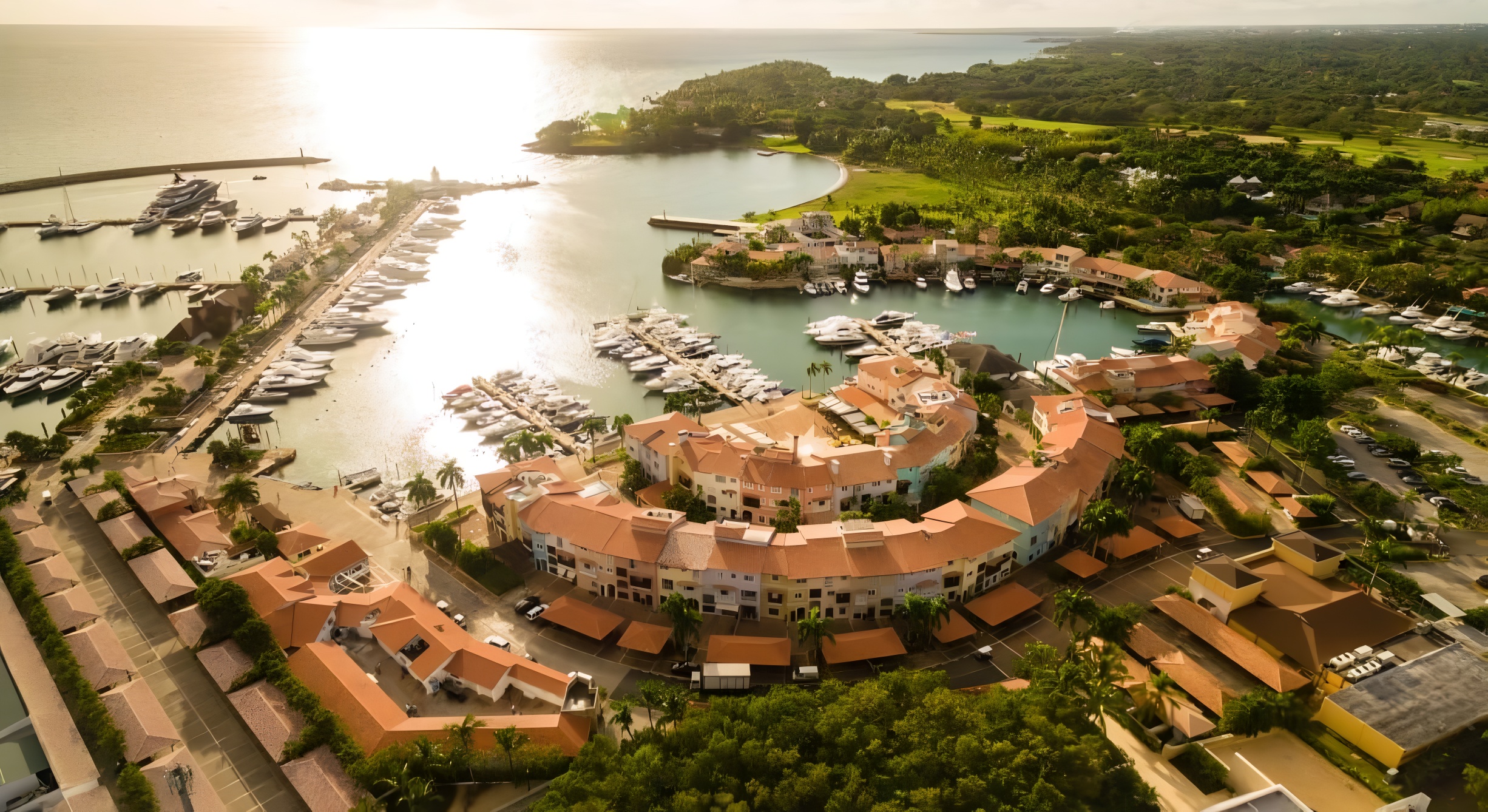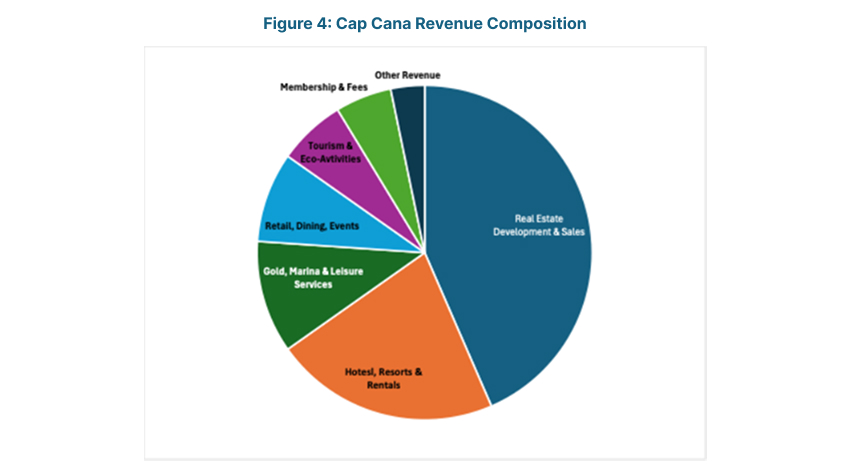
Profiles of Successful Real Estate Developments
August 25, 2025
Over the past two decades, the Dominican Republic (DR) has emerged as a premier destination for luxury and integrated real estate developments. This growth is fuelled by a combination of strategic geographic positioning, robust tourism infrastructure, and favourable investment policies. The DR now ranks among the top Caribbean nations for foreign direct investment (FDI) in real estate, with luxury developments playing a central role in this expansion.
Successful real estate developments in the Dominican Republic are distinguished by a combination of strategic planning, supportive policy frameworks, and alignment with global luxury and tourism trends. At the heart of these developments is integrated master planning, which ensures that each project is not just a collection of homes, but a fully realized community. These master-planned environments typically include world-class golf courses, marinas, international schools, healthcare facilities, and branded hotels. This holistic approach enhances the lifestyle appeal for both residents and investors, creating a self-sustaining ecosystem that supports long-term value.
Government incentives, particularly through the CONFOTUR law, play a pivotal role in attracting investment. This legislation provides significant tax exemptions on property and transfer taxes, making the Dominican Republic an especially attractive destination for foreign buyers and developers. These incentives reduce the financial barriers to entry and encourage the development of high-quality infrastructure and amenities.
Tourism integration is also a defining feature. These developments are often designed to complement and enhance the country’s tourism offerings. Resorts, cultural events, and recreational facilities are seamlessly woven into the fabric of the community, attracting a steady stream of visitors and generating additional revenue streams.
High-end partnerships further elevate the prestige and appeal of these developments. Collaborations with globally recognized luxury brands and hotel operators bring credibility, quality assurance, and international visibility. These partnerships often result in branded residences and resort-style services that appeal to discerning buyers.
Integrated communities like Cap Cana and Casa de Campo exemplify this trend. These developments are not just residential zones—they are self-contained ecosystems offering golf courses, marinas, equestrian centres, private beaches, and high-end hospitality. Their success has helped position the Dominican Republic as a hub for affluent second-home buyers, retirees, and international investors.
Located near Punta Cana International Airport, Cap Cana spans over 30,000 acres and includes luxury villas, condominiums, and branded residences. Its master plan integrates residential, commercial, and recreational spaces, including the world-renowned Punta Espada Golf Course and Marina Cap Cana.
Cap Cana was officially launched in 2002, envisioned as a high-end, master-planned destination on the eastern coast near Punta Cana. The development was ambitious from the outset, aiming to combine luxury living with tourism and recreation. A major milestone came in 2006 with the opening of the Cap Cana Marina, one of the most advanced in the Caribbean, capable of accommodating mega-yachts and serving as a hub for sport fishing and nautical tourism. This infrastructure not only elevated Cap Cana’s appeal to affluent travellers but also positioned it as a serious contender in the global luxury marina market.
By 2008, Cap Cana had entered strategic hotel partnerships, bringing in internationally recognized hospitality brands such as the Sanctuary Cap Cana and later Hyatt’s Ziva and Zilara resorts. These partnerships were crucial in attracting global clientele and establishing Cap Cana as a luxury lifestyle destination. The integration of branded residences and resort services further enhanced its value proposition for investors and second-home buyers.
From 2021 to 2025, Cap Cana has seen a steady increase in property values—from $1,980 to $2,400 per square meter—driven by high-end tourism and infrastructure investments. Rental yields have risen from 6% to 8%, reflecting strong demand for short-term luxury rentals. The development benefits from proximity to an international airport, tax incentives for foreign investors, and a growing reputation as a luxury destination.

Casa de Campo, located in La Romana, is one of the Caribbean’s most established luxury communities. Known for its iconic Teeth of the Dog golf course and celebrity clientele, it offers a more mature and stable investment environment.

Casa de Campo, launched in 1970, is one of the earliest and most iconic luxury developments in the Caribbean. Developed by Gulf + Western and later acquired by the Central Romana Corporation, it set the standard for integrated resort communities in the region. Its early success was anchored by the creation of the Teeth of the Dog golf course, designed by Pete Dye, which quickly gained international acclaim.
In 1980, Casa de Campo expanded its offerings with the opening of its marina, designed to resemble a Mediterranean village. This addition significantly enhanced the lifestyle and recreational options available to residents and guests, reinforcing its status as a premier destination for yachting and waterfront living.
By 1990, Casa de Campo had established hotel partnerships and expanded its hospitality infrastructure, including the Casa de Campo Resort & Villas. These developments attracted a global clientele, including celebrities, business magnates, and heads of state, and helped solidify its reputation as a luxury enclave with a strong sense of community and exclusivity.
According to Noriega Group, Cap Cana’s real estate has grown by 35% over the past five years—approximately a 6 – 7% annual appreciation. Boutique luxury communities—such as Marea Golf & Spa Residences—have seen 20% growth in just the last two years, showing the strength in premium niche developments. Industry reports cite 10–15% average annual increases in luxury home values in Cap Cana. However, broader DR data suggests national-average price growth around 8% per year, with beachfront and resort communities seeing up to 9%+ annually. Developers and real estate agents highlight Cap Cana (along with Punta Cana Village) as areas with best long-term appreciation, especially for pre-construction and branded-residence projects.

Cap Cana is a cornerstone of high-end tourism in the Dominican Republic, contributing significantly through direct revenues from luxury real estate, hospitality, and tourism. Its operations create a multiplier effect, sustaining thousands of jobs, supporting local suppliers, and driving foreign investment inflows. With an integrated offering of villas, hotels, a marina, golf, and commercial services, Cap Cana enhances the country’s global tourism competitiveness while reinforcing regional economic resilience. Cap Cana revenues are generated from various streams. Real Estate Development & Sales contributes to 40-45% of the total revenue. High-value land sales attract FDI, stimulates construction, architecture, and legal sectors. This includes sale of high-end residential lots, villas, condos, and commercial plots. Also, land development, infrastructure provisioning, and luxury property sales to international and domestic buyers attracts foreign direct investment (FDI) from private buyers and real estate developers. It also stimulates construction, architecture, engineering, legal, and banking sectors. generates significant property taxes and transfer fees for the Dominican government and encourages long-term residency or repeats tourism, boosting surrounding services.

Hotels, Resorts & Rentals contributes to 20% of the total revenue. This Includes revenues from nightly stays, long-term luxury rentals, and resort operations. Flagship hotels and branded residences are managed by major global hospitality brands. This drives job creation in hospitality, housekeeping, F&B, and management, directly contributes to tourism GDP, supports hospitality training programs generates tourism taxes and a VAT on services, and attracts high-spending international visitors, increasing foreign currency inflow. About 10% of the revenue is generated from Golf, Marina & Leisure Services. This includes Golf course fees e.g. Punta Espada Golf Club, Marina docking fees, maintenance, and luxury yachting services and spa, wellness, and recreational activities. Revenue from upscale restaurants, cafes, boutique shops, and event venues contribute to around 8%. This also includes venue rentals for private events like weddings, corporate retreats, and galas. It enables local entrepreneur participation via restaurant leases and retail concessions, multiplies tourist spending across entertainment and leisure, and supports culinary employment, nightlife operators, decorators, planners, and caterers. Tourism & Eco-Activities generates around 6% of the revenue. This includes Adventure tourism such as ziplining, hiking, horseback riding, cave tours. Excursions to national parks, ecological reserves, and surrounding towns impact the economy by promoting sustainable tourism and ecological awareness. Supports local guides, transport operators, and nature reserves. Attracts environmentally conscious travelers and helps diversify Cap Cana’s visitor base. Recurring revenue from golf, marina, and wellness club memberships accounts for 5% of the total revenue. This also includes service and access fees for private community features. It provides reliable long-term income for operations and maintenance. Indicates a stable, committed resident population with repeat spending potential. This enhances community upkeep, contributing to property value appreciation. Other revenue (3%) includes licensing income, property management fees, brand partnerships, and utility services.
Casa de Campo continues to play a pivotal role in the Dominican Republic’s luxury tourism and real estate sectors. Its unique blend of elite sports infrastructure, marina services, cultural offerings, and residential investment has generated robust economic ripples across La Romana and beyond. With over five decades of operation, it has matured into a high-impact economic engine attracting global capital, talent, and tourists.

Luxury Real Estate Sales & Rentals contributes to 40% of the total revenue. This includes sale and rental of luxury villas, estates, and residential plots, ongoing property management and renovation services. It attracts buyers from the U.S., Europe, Latin America, and the Dominican elite. It is a major driver of foreign direct investment in La Romana. Spurs growth in construction, architecture, interior design, and legal services. It generates property transfer taxes, HOA fees, and employment in real estate support services (e.g., maintenance, landscaping, security). Villas often come with full-time domestic staff, stimulating steady job creation. Hotels & Resort Operations contributes to 20% of the revenue generation. Includes Casa de Campo Resort & Villas, a luxury hotel offering rooms, suites, and villa packages. Features centralized guest services, concierge, and wellness programs. Anchors the region’s hospitality workforce, from housekeeping to senior management. Generates high-value tourism taxes (e.g., VAT, lodging taxes). Supports allied services (e.g., laundry, transport, event management). Guests often spend on additional experiences, multiplying local earnings. Golf Operations , including that of – Teeth of the Dog, Dye Fore, The Links, contribute 15% of the revenues. This includes renowned golf courses designed by Pete Dye, attracting global sport tourists. Offers memberships, green fees, tournaments, and training programs. Casa de Campo is a golf tourism destination, attracting affluent international visitors. Tournaments stimulate hospitality, media, and event services. Creates jobs: golf pros, caddies, groundskeepers, and sales staff. Golf-related retail sales (equipment, apparel) benefit local shops. Marina & Nautical Services contributes to 8-10% of the revenue generation. Retail, Restaurants & Entertainment contributes to 8-10% of the revenue stream. Membership & Private club fees account to 3-5% of the revenues.
Punta Cana Resort & Club is one of the Dominican Republic’s most prestigious and expansive luxury developments, located in Punta Cana just minutes from the Punta Cana International Airport. Spanning approximately 15,000 acres, this resort community was initially launched in the 1980s and has undergone significant expansion throughout the 2000s. With investments totaling hundreds of millions of dollars over the decades, the resort has become a benchmark for integrated luxury living. It is home to Tortuga Bay, a boutique hotel that is part of the Leading Hotels of the World, and features villas designed by the legendary Oscar de la Renta. The development also boasts two world-class golf courses—Corales and La Cana—an ecological reserve, private beach clubs, and an international school. Its success is largely attributed to its direct ownership of the airport, which ensures seamless access for international visitors, as well as its strong emphasis on eco-tourism and sustainability. The resort has attracted a high-profile clientele, including celebrities and global elites, reinforcing its status as a premier destination.
Sosúa Ocean Village, located on the North Coast near Puerto Plata, offers a more compact yet vibrant alternative. Launched in the early 2010s, this 100-acre development has seen an estimated investment of over $50 million. It features oceanfront villas and condominiums, complemented by a wide range of amenities including a water park, gym, spa, and multiple restaurants. Designed with families in mind, the community is both pet-friendly and family-oriented, offering a relaxed and inclusive atmosphere. Its success lies in its ability to deliver affordable luxury with strong rental yields, making it attractive to both investors and vacationers. The development’s proximity to Gregorio Luperón International Airport further enhances its accessibility and appeal.
Las Terrenas, situated on the Samaná Peninsula in the northeastern part of the country, represents a different model of luxury development. Rather than a single master-planned community, Las Terrenas comprises multiple boutique projects that have emerged since the early 2000s. These developments emphasize eco-luxury, with villas and beachfront condos that blend seamlessly into the natural landscape. The area is known for its pristine beaches, lush hills, and a laid-back lifestyle that appeals particularly to European expatriates and digital nomads. Investment levels vary by project, but the region has seen steady growth thanks to improved infrastructure, including new highways and an airport. Las Terrenas’ appeal is rooted in its untouched natural beauty and its alignment with the values of eco-conscious buyers seeking sustainable and serene living environments.
The Dominican Republic has successfully positioned itself as a premier destination for luxury real estate through a combination of visionary master planning, strategic government incentives, and seamless integration with its thriving tourism sector. Flagship developments like Cap Cana and Casa de Campo exemplify the country’s ability to create self-sustaining, high-end communities that appeal to both lifestyle buyers and global investors. Their consistent growth in property values, diversified revenue streams, and strong brand partnerships underscore the resilience and appeal of the DR’s real estate market.
Moreover, the emergence of diverse projects such as Punta Cana Resort & Club, Sosúa Ocean Village, and Las Terrenas reflects the market’s adaptability and broadening appeal across different buyer segments—from eco-conscious investors to family-oriented vacationers. With continued infrastructure development, international accessibility, and a stable investment climate supported by policies like the CONFOTUR law, the Dominican Republic is well-poised to sustain its momentum and remain a leader in Caribbean luxury real estate for years to come.

